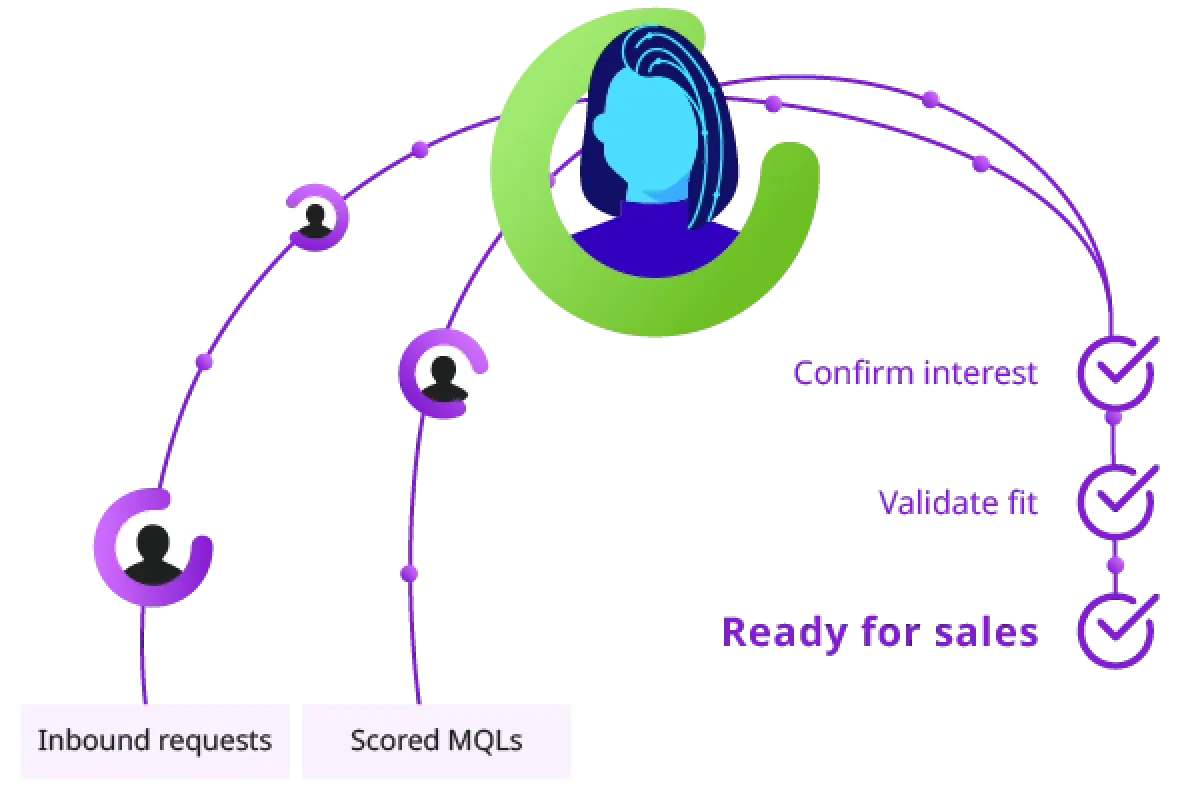Conversational AI use cases that are changing business as we know it
Conversational AI has the power to transform the way we do business and interact with customers. Here are the most exciting use cases.

Even though generative AI has stolen a lot of the spotlight over the past two years, conversational AI is starting to generate some major buzz, especially in the business context.
This technology, built to mimic human interactions through a conversation-like experience, depends on algorithms that attempt to understand, process, and respond to human language as naturally as possible.
Some of these tools you may be familiar with in your day-to-day life, i.e. voice assistants like Siri or Alexa. But there are other tools like virtual assistants or chatbots that are powered by this technology.
The benefits of conversational AI
Before we start talking about the most impactful conversational AI use cases, I want to lay out the (many) benefits that businesses specifically can get from using this emerging technology.
Improving efficiency and reducing operational costs
Conversational AI extends the abilities of your team members. It takes tedious tasks off of their plates and gives them the tools to do the things that they do best, better. It’s one of the best and fastest-growing strategies to improve efficiency on your team.
In call centers, for example, conversational AI tools reduce costs by about 65% on average due to the boost in efficiency that they deliver.
Providing personalized experiences
The perks that conversational AI delivers for personalization capabilities go hand in hand with better efficiency. Doing personalization right is a massive lift if you’re relying on human team members to shoulder the burden. Conversational AI helps you efficiently achieve real-time personalization.
But it doesn’t just help you personalize experiences quicker and more efficiently, it helps you do it better. Conversational AI tools can go deeper and leverage more information in real time than a human ever could. For example, when someone is chatting with a bot powered by conversational AI, the system can pull in contextual clues, adapt to their tone, and take usage history into account seamlessly.
Segment-level personalization has been in vogue for a while, but conversational AI helps you scale individual-level personalization.
Scalability and 24/7 availability
Customers don’t usually confine their interactions to during work hours. You may or may not have 24/7 support teams, but you almost certainly don’t have 24/7 staff on the other teams we’ll touch on below, like your marketing and sales or product team.
Conversational AI helps you expand your reach to be there for your customers (or potential customers) every time they need it, without having to rely on human staff.
Data collection and insights
Survey data is great, conversational data is even better. When your customers engage with conversational AI tools, you’re able to pull out rich data about their needs, frustrations, and delight about your product. Sure, you’re probably already collecting data from things like support tickets or social media listening, but conversational AI can actively probe and pull out more information than you would otherwise get.
This gives you fuel throughout the entire organization, whether it’s data on how to improve the onboarding process, product updates to prioritize, or marketing campaigns to invest in.
Conversational AI use cases across industries
Customer service
As I teased earlier when I mentioned the massive cost savings that conversational AI can drive in call centers, there are several great conversational AI use cases in customer service.
Automating customer support
This is a broad category that can include a variety of different support tasks. Essentially, conversational AI tools — whether chat-based or voice-based — can take some tasks off your human support team’s plates.
These support tools can be at your customers’ beck and call to support them with whatever they need. And because of the power of conversational AI platforms, information about past interactions, current subscriptions etc. can be used to provide highly relevant and personalized responses.
One of the most useful ways that companies use this is for technical support. There are likely some common issues that customers run into with your product. When you feed the right information into your conversational AI tool, it can guide customers through step-by-step solutions, freeing up support agents for more complex tasks that only they can handle.
Order management
Your support teams have better things to do than handle Shopify order management tasks. Luckily, this is one thing that conversational AI can nail easily.
Using a chatbot or voice assistant functionality, customers can check the status of their orders, pull shipping details, and get insight into delivery timelines for their products.
AI can also assist with managing returns and refunds by initiating return processes, providing refund information, and answering any related queries.
One great example of a conversational AI tool that helps to put a lot of customer support tasks on auto-pilot is Amtrak’s Julie. Julie is actually one of the pioneers of the conversational AI space and originally put Amtrak on the map for her abilities to provide support on the phone.
Customers are now able to chat with Julie online and, in their own words, ask about a variety of issues.
Here’s just a taste of what Julie can handle:
- Booking reservations
- Planning a vacation
- Frequently Asked Questions
- Navigating Amtrak.com
- Amtrak Guest Rewards program
- Station and route information
- Policies
Sales and marketing
Although conversational AI has perhaps had the biggest impact on the customer support space, there are several emerging conversational AI use cases in sales and marketing.
Lead qualification
Conversational AI can significantly enhance lead qualification by acting as a personal assistant that pre-screens leads, making sure your sales team doesn’t waste their time on leads that don’t fit the right criteria. Based on initial chat interactions, AI systems can qualify or disqualify potential leads based on predefined criteria.
By analyzing responses and engagement patterns, AI can assess a lead's interest level and readiness to buy. This helps you to prioritize leads that are more likely to convert, optimizing the sales funnel and accelerating the sales cycle.
One tool that can do exactly this is called Conversica. They lay out the perfect scenario to use this tool on their website: “Is the high-scoring lead who downloaded five technical white papers a qualified decision-maker or just a student doing research?”

Conversational AI can help to warm up your leads from the moment they hit your website. In conversations that feel like they’re talking to a real person, prospects can ask questions that allow your virtual “salespeople” to guide them through specific product features and benefits to pique their interest.
You can either personalize based on the page they’re currently on, engagement history, or any other criteria that is specific to the individual the bot is talking to.
Renewal management
Another great conversational AI use case in marketing/sales is automated renewal management.
Automated systems can send timely reminders before a subscription expires, reducing the chance that someone will forget to renew or even decide not to renew.
AI can send personalized offers based on usage patterns, suggesting higher-tier services or additional features. This approach boosts renewals and upsells more valuable services, which in turn increases revenue and loyalty.
SaaS (Software as a Service)
The SaaS industry is a goldmine for opportunities to constantly identify new, value conversational AI use cases. Because of the totally online, interactive nature of software, conversational AI gives product teams the opportunity to totally revolutionize and personalize the experience users have in their platform.
Enhancing user onboarding experiences
Onboarding is a critical moment in the SaaS user journey, because it sets the tone for how users will continue to engage with your product over time. So wouldn’t it be nice if users could have someone by their side to support them at every moment. Oh wait, with conversational AI, they actually can.
Even though teams spend tons of time creating the perfect onboarding flow, trying to anticipate every problem that could potentially arise, and perhaps even personalizing the experience, there are inevitably going to be problems that pop up.
Conversational AI tools can be there to answer questions, explain concepts, and give guidance on the next steps in the process.
Providing in-app support and tutorials
SaaS products are constantly evolving with new and updated features launching regularly, and user’s engagement patterns are also constantly changing, with them adopting new features or trying to get more value out of the platform. Because of this, user assistance is necessary long past onboarding ends.
Conversational AI gives users hands-on support any time they run into uncertainty. With Command AI’s Copilot, for example, users can access step-by-step, interaction tutorials that help them not only get answers to their questions, but also helps them take actions directly from the chat.
User feedback collection and analysis
Like I mentioned earlier, conversational AI gives you insane amounts of data to work with, so it’s a valuable technology to incorporate into your customer feedback collection process. You can integrate this tech into the surveys you send out, but you can also be pulling information at all times, using chat records from support or onboarding flows, too, to inform your strategy.
By engaging users in real-time, AI can gather insights seamlessly during interactions, whether through surveys, chatbots, or voice assistants. This continuous feedback loop helps businesses understand customer needs and preferences more accurately.
Analyzing this data can help you identify trends, pinpoint issues, and make data-driven decisions. Since AI can process and interpret feedback quickly, you’re able to quickly respond to customer concerns, enhance product offerings, and improve overall customer satisfaction.
Future Trends and Potential Developments
As exciting as conversational AI is looking now, it’s clear that we’re now just seeing a fraction of the possibilities that this technology can achieve over time. While we don’t know exactly what the future of conversational AI holds, there are some clear developments on the horizon.
Increased integration with IoT devices
IoT (Internet of Things) devices are kind of what launched conversational intelligence into the consumer space. With the rise of things like smart home devices powered by Alexa, people are getting more and more used to conversing with AI. Just within the last few weeks Apple announced Apple Intelligence, which is their AI solution that will have a big impact on Siri, their conversational AI voice assistant, marking a major moment in their history.
As conversational AI continues to improve, it will become increasingly integrated with more IoT devices like smart appliances, wearables, and connected vehicles.
Imagine a future where your refrigerator can suggest recipes based on its contents, or your car can schedule its own maintenance appointments by conversing with a service center. These integrations will make everyday tasks more seamless and efficient. And to bring this back to the business context, all of these advancements can make it easier than ever to better engage and deepen relationships with customers.
Better emotional intelligence
As technology continues to evolve, the gap between human emotional intelligence and artificial intelligence is getting smaller.
There are several LLMs that are increasingly incorporating more advanced emotional understanding into their conversational AI. Even subtle emotional nuances, through tone, word choice or speech patterns, are beginning to be detected and analyzed. Complicated emotional nuances like sarcasm or frustration are even able to be identified now, and will undoubtedly be better identified in the future.
Since the goal of conversational AI is to mimic human communication as closely as possible, emotional understanding is perhaps the most important capability to engrain in these tools. With this, communication will be much more effective, because the “robots” would be able to adjust their behavior and responses to what the people on the other end need in that moment, whether it’s empathy, support, joy, or anything else.
Predictions for conversational AI's role in emerging industries
We mentioned a few of the industries that are currently most positively affected by conversational AI tools, but that list is far from exhaustive. And there are several industries that will only continue to develop more and more skin in the conversational AI game.
Here’s where the most potential is starting to be seen:
- In healthcare, conversational AI is expected to help take some load off of doctors and nurses by helping with virtual diagnostic visits.
- Virtual mental health care has already been trending, but soon AI-powered chat is expected to help fill even larger gaps to provide lower cost care that’s still personalized.
- In education, conversational AI is showing promise in acting as personalized learning assistants and tutors, as well as an admin assistant for teachers, helping with tasks like scheduling and grading assignments.
- In finance, AI bots have potential for helping consumers with personalized investment advice.
I’m personally excited to see what conversational AI use cases pop up next!
Some of these use cases were in their infancy just a year or two ago and are now almost common practice. It's really exciting to think that some of the best ways to leverage this powerful technology is something we may not even be able to picture now.
Here on the Commandblogue, we’re definitely going to be keeping our eye out for all of this exciting innovation that’s coming our way, so make sure you keep coming back so you can stay in the loop, too.
